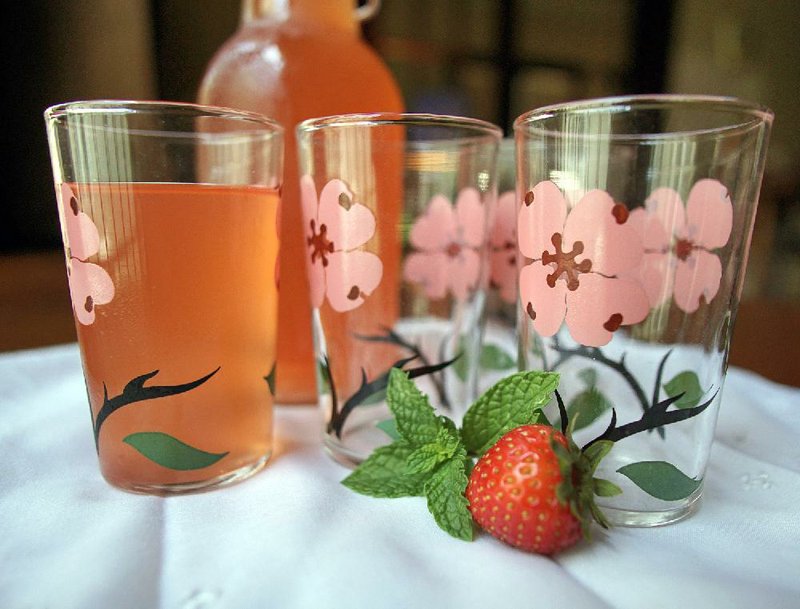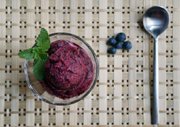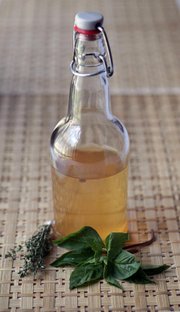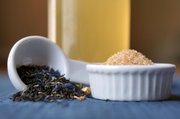As with any diverse, thriving community, there is a creation story. Once upon a time about 2,000 years ago, an insect fell into a vat of sweet tea, trailing bacteria that colonized with local yeast. In the manner of empires, this first symbiotic culture of bacteria and yeast (commonly called a SCOBY or scoby) birthed vast colonies in new lands. A Korean doctor reportedly used the fermented tea to heal a Japanese emperor around A.D. 414. Five hundreds years later, it jostled in samurais' wine bags, an early take on Gatorade, and five hundred years after that, soldiers returned from the Russo-Japanese war to plop scobys in vats across Eastern Europe.
In 1968 Russian author Alexander Solzhenitsyn wrote that the fizzy, fermented, sweet-tart beverage cured his stomach cancer, prompting President Ronald Reagan to settle a scoby into the White House upon his own cancer diagnosis in 1985. By 2015, fermented tea had become a $600 million global industry.
Of course, with any creation story, fact is rooted in myth.
What we now call kombucha, the Chinese knew as the "tea of immortality." The tea was a popular folk remedy in the Eastern Bloc, where more than 100 studies were performed between 1926 and 1935, testing its effectiveness as treatment for everything from digestive woes to mental illness. It contains trace levels of alcohol, not enough for it to need to be regulated or have any effect.
Modern research is limited and cautiously optimistic regarding kombucha's health benefits, but nothing supports the miraculous claims that history has heaped upon the little scoby that could. (Could grow, that is. A healthy scoby spreads into a kudzu-like blob in a few unchecked weeks.)
The scoby, which resembles a jellyfish with trailing brown yeast tentacles, is why kombucha has been mislabled mushroom tea. Roughly every week a new layer forms, so that in about a month, a gallon home-brew could have a scoby an inch thick. A growing scoby is a healthy scoby, but a thick scoby will choke the oxygen from your tea, slowing the fermentation process and eventually, killing the useful bacteria and yeast.
When the layers of a scoby peel apart easily, that's how Emily Cassidy, 25, Arkansas' first commercial kombucha brewer, knows it's time to separate the "baby" scoby from its "mother." The offspring are often passed to friends, who use them to start new home brews.
Cassidy started home brewing in 2011. Three years later, she founded Moniker Ferments in Fayetteville. Now her kombucha is available canned and on tap in a dozen restaurants and bars around Northwest Arkansas, and Cassidy brews between 300 and 500 gallons a month.
JUST THE BASICS
To brew your own kombucha, you need caffeinated tea, sugar (cane is best, although honey or maple syrup should work), a large glass or stainless-steel jar with an opening wide enough to shove a hand through, a thin cloth and a scoby. (Handle your scoby with clean hands, and avoid ceramic jars with unknown or lead glazes or jars with metal spigots, since metal can leach into tea.)
Finding a good scoby can be tricky. Naked Hippie Brew, a commercial brewer in Beebe, sells fresh scobys for $20 at its brewery, 305 West End Drive. JR's Kombucha (ejrkombucha@gmail.com), another commercial brewer in Fayetteville, sells refrigerated scobys for $10 out of Generations Health and Wellness Center. North Little Rock's Fermentables & Homegrown Hobbies sells dehydrated scobys for $12.99, and it takes about a month to rehydrate the scoby before it can be used for brewing.
Aspiring home brewers can also try another option that we had success with -- adding a nonpasteurized, commercial bottle of unflavored kombucha to a cup of cooled black or green tea, sweetened with two tablespoons of sugar. After covering the container with a thin, clean cloth, you should see growth in seven to 21 days. (We had a mature scoby in about two weeks.) Commercially bottled kombucha is available at natural food stores and some supermarkets.
Once you have a scoby, brew your tea (let the water boil to kill any bacteria), cool it, and place it in the jar with the scoby and a cup of "starter" -- strong, unpasteurized kombucha, obtained from a healthy home brew or commercial brew. Then cover it with cloth and wait. Depending on temperature and taste, most kombucha is ready in a week or two. The longer it ferments, the more sour it becomes. If it ferments for months, it turns to vinegar.
"The biggest challenge for us through the winter is keeping a stable environment for the kombucha, because it needs to stay between 60 degrees and 85 degrees," Cassidy says. "You're brewing something raw and just letting it sit in an open space for several weeks, so why doesn't that mold? And the answer is that pH between 2.5 and 4.5 is a natural barrier for anything unhealthy."
You can test the pH with litmus strips, available at brewing supply stores. When the pH is off, your scoby may develop a green or white fuzzy mold. If that happens, toss it, sterilize the jar and start over.
SKEW THE BREW
No two batches of kombucha taste the same. Obvious factors, such as the type of tea and length of fermentation, and less obvious factors, such as organisms in the air, affect flavor. But there are also overt ways to manipulate your brew. Fresh or dried fruit, herbs, syrups and even vegetables can be used to flavor kombucha during a secondary fermentation process. Place the flavoring agent in the bottle, pour the kombucha on top, leave about an inch for carbonation (to avoid exploding bottles), and let the bottles sit unrefrigerated for a few days. When the tea is ready, you can filter out the flavoring material if you wish.
Moniker Ferments' most popular tea is a berry rooibos blend, with dried blueberries and hibiscus. But if you brew a batch of herbal or low-caffeine tea, Cassidy recommends returning the scoby to caffeinated tea after, since it needs caffeine to thrive.
Cassidy's personal favorite is pu-erh kombucha, a dark, earthy Chinese tea in which the leaves are fermented and aged before being brewed. When kombucha is made with pu-erh, it undergoes a second fermentation process. "It's like a super-fermenty, tart lemonade," Cassidy says.
Emily Cassidy's Favorite Home Brew
1 gallon water
4 teaspoons of loose-leaf tea (Oolong is a good choice)
1 cup organic, unrefined cane sugar such as Sugar in the Raw or Morena sugar
12 ounces of "starter" kombucha (bought or from a friend)
1 scoby (bought, from a friend or homegrown -- recipe follows)
Steep tea in filtered, room-temperature water for 12 hours or boiling water for 5 minutes. Stir sugar into tea until dissolved. Let water cool to room temperature (hot water will kill the scoby). Pour 12 ounces of "starter" kombucha (bought as ready-to-drink or procured from another home-brew) into a glass or stainless-steel container, along with the brewed tea. Place the scoby on top (handle with clean hands), cover with a cotton towel, and secure towel with a rubber band or string. Keep between 70 degrees and 90 degrees for 7 to 21 days, to taste.
Recipe courtesy of Emily Cassidy with Moniker Ferments
Home Grown Scoby
1 cup brewed hot black or green tea
2 tablespoons unrefined cane sugar such as Sugar in the Raw or Morena sugar
1 bottle unflavored commercially brewed nonpasteurized kombucha
In a large glass jar or stainless-steel vat, combine hot tea and sugar and stir to dissolve sugar. Cool to room temperature, then add the unflavored kombucha and mix well. Cover container with a thin, clean cloth and leave at room temperature (65 degrees to 85 degrees), away from direct sunlight, for 7 to 21 days. After one week check mixture for scoby growth. The scoby will start out as a thin, translucent film on the surface and thicken and turn opaque as it grows. If there are signs of black or green mold, discard mixture, sterilize your equipment and begin again.
Strawberry Mint Lime Kombucha
1 gallon already brewed and fermented kombucha in a glass or stainless-steel jar with a tight-fitting lid
1 cup chopped fresh strawberries
1/4 cup fresh mint
1 lime, juiced
Remove the scoby and place the strawberries, mint and lime juice in the kombucha. Close tightly and leave in a temperate spot, away from direct sunlight, for three days. On day three, strain and enjoy.
Courtesy of Jenny Lively with A Lively Brew in Hot Springs
Love Potion Sorbet
2 cups pureed fresh or frozen blueberries
2/3 cup sugar
1/3 cup simple syrup
1 1/2 cups kombucha
1 tablespoon rose water (may substitute 11/2 teaspoons vanilla or almond extract)
2 drops lavender essential oil (optional)
Combine the blueberries, sugar and simple syrup in a saucepan over medium heat. Bring to a simmer, remove from heat and refrigerate for two hours. Stir the kombucha into the blueberry mixture. Pour the mixture into an ice cream maker and add the rose water and lavender oil. Churn for half an hour, then freeze until set.
Adapted from The Big Book of Kombucha by Hannah Crum Alex LaGory
Basil and Thyme Kombucha Vinegar
1 tablespoon chopped fresh basil
1 teaspoon dried thyme
1 quart kombucha vinegar (kombucha that has been fermented for four to 10 weeks; to increase acidity, add 2 teaspoons of sugar six weeks in)
Combine the herbs and vinegar in a sealed bottle (leave plenty of space at the top to avoid massive spewing and/or broken glass) and allow to infuse for 2 to 3 weeks in a cool, dark location. Strain out the flavoring agents and discard any scoby that may have formed. Refrigerating the vinegar will stop the fermentation process.
Makes about 1 quart.
Adapted from The Big Book of Kombucha by Hannah Crum Alex LaGory
Food on 07/13/2016



